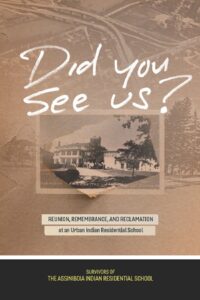Book review: Did You See Us?: Reunion, Remembrance, and Reclamation at an Urban Indian Residential
 Reviewed by Carrie MacKenzie
Reviewed by Carrie MacKenzie
Did You See Us?: Reunion, Remembrance, and Reclamation at an Urban Indian Residential by survivors of The Assiniboia Indian Residential School is an emotional collection of memories of former students and teachers of The Assiniboia Indian Residential School and people from the surrounding neighbourhood.
This residential school operated from 1958-1973 and was located in Winnipeg Manitoba. It was the first residential high school to be located in that province and one of the only ones in a large urban setting.
This collection of memories serves as an eye-opening and educational tool. It has a sense of authenticity and uniqueness because anecdotes from former teachers and community members are included. This ensures that this compilation is not seen as one-sided. This is further enhanced by the addition of survivors’ recollections of how they were treated by members of the community, at other residential schools, and the police; thus giving a well-rounded picture of the obstacles faced by Indigenous people then and now. These issues include the intergenerational effects of being removed from your family and culture as well as the dehumanizing treatment they suffered. The long-term repercussions of this trauma on individuals are also brought to light. It also makes it easier and more comfortable for those whose knowledge of and exposure to various topics surrounding residential schools is limited to absorb what they are reading and learn from it as they do not feel that any animosity is being directed at them.
Another facet of this collection that makes it unique is that several survivors tell their stories in the form of poems. This makes the book more personal, allowing the reader to connect to the story on an emotional level and learn from the survivors’ stories.
The fact that the memories are written by survivors, former teachers and community members, or transcribed from oral interviews makes it more real and personal because it is recorded the way the individual speaks. You feel almost as if they are right there and having a conversation with you. This increases the reader’s investment in and connection to what they are reading.
The pictures included also help readers form a connection with the authors— making it more real. The reader can put a face to the name making what they are reading more real, therefore it is harder to discount or minimize the experiences that they are reading about.
The tone of this book is matter of fact, with a sense of frustration and sadness, but no anger. This makes it easier for audiences to read and keep reading as they don’t feel that they are being blamed for what happened. This increases the effect of this collection, making it more relatable, widening the reach and influence of this work.
There is also a sense of hope emanating from the recollections of the community members.
Some helped to organize reunions for the survivors and as a result, the city of Winnipeg is learning about the Assiniboia Indian Residential School. This is significant, as some community members interviewed said they were not really aware of the reality of residential schools and the related issues. This gives the reader hope that reconciliation is possible.
This book is an excellent example of people telling their truths and a community realizing the mistakes of the past, coming together, and moving towards reconciliation. Within these stories, there are lessons that we can all learn from and step towards reconciliation.
Did You See Us?: Reunion, Remembrance, and Reclamation at an Urban Indian Residential School, Survivors of The Assiniboia Indian Residential School, Andrew Wilford (editor), University of Manitoba Press, 2021.
ISBN 978-0-88755-907-5


